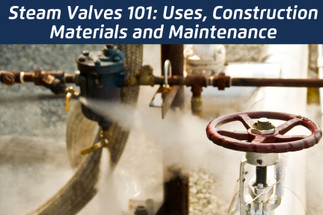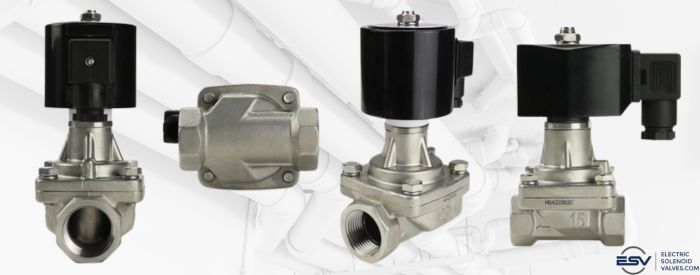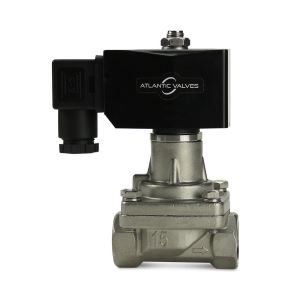May 23rd 2023
Steam Valves 101: Uses, Construction Materials and Maintenance
Steam is indispensable across different industries, proving beneficial for power generating facilities, petrochemical industries, and food processing plants. These are high-pressure, high-temperature applications exerting extreme stress on flow control devices. Steam control valves are unique in construction and performance to meet aggressive operating environments while providing reliable and durable steam service. These valves ensure steam travels in the right directions and flow rates.
Sizing valves for steam service takes into account different properties of steam. Engineers deal with saturated (up to 250 degrees centigrade) and superheated steam (up to 400 degrees centigrade). It implies process engineers must evaluate specific properties of each steam supply system to customize flow control mechanisms.
Steam exhibits distinct characteristics as it interacts with various heat transfer surfaces. This includes interaction with steam valves which alter the pressure, flow rates and temperature. There are several types of control valves for fluid service, including:
- Steam solenoid valves
- Ball valves
- Butterfly valves
- Globe valves
- Plug valves
This article explores the desirable features of steam control valves, best practices for installing and utilizing steam valves, considerations for sizing steam valves and an in-depth look into steam solenoid valves.
Characteristics of Steam Valves
The first steps towards guaranteeing the durability and safety of steam service valves are properly sizing valves and choosing the correct fabrication material. Steam, supplied to processes at a specific pressure, undergoes various phase changes transferring heat to surfaces in contact. Steam can condense as it moves past valves and heat exchange occurs. Although the volume of condensate in any instance is small compared to supplied steam, it significantly affects pressure in designated steam spaces.
Reducing pressure in steam spaces creates a pressure difference across valves, allowing pressurized steam to flow into low-pressure zones of the process or piping system. Process valves for steam service should provide adequate flow rates to prevent excess condensation, which impacts the efficiency and heat exchange rates across piping systems. This implies valve sizing must cater to specifics like orifice sizes, allowable pressure drops across valves and heat transfer coefficients of valve manufacturing materials.
The desirable features of valves for steam service are:
Heat Resistance
The temperature of steam can reach 400 degrees centigrade. Valves, vital for controlling service fluids, can undergo rapid degradation if the fabrication materials cannot accommodate these elevated temperatures. High temperature exerts continuous thermal stress on the valves, leading to repetitive expansion and contraction. The impacts of excess temperature can be more evident if the valve is poorly sized and allows rapid condensation. It exacerbates material degradation, reducing its structural strength.
Extreme process temperature can cause sealing issues, leading to steam leakage around valves. Steam can cause non-uniform expansion of sealing materials and valve packing. Heat can also cause warping or distortion of flow control mechanisms (discs, balls, or orifices), causing uneven valve shutoff characteristics and increasing leakage rates.
Steam service valves should be fabricated from high-quality materials with reliable heat resistance. They should offer dependable service at the designated steam and process temperatures. Valve materials providing adequate heat resistance include:
- Carbon steel (ASTM A216)
- Stainless steel
- Bronze
- Alloy steel
- Nickel alloys (Inconel and Hastelloy)
Sealing materials suitable for high-temperature steam applications include:
- Graphite
- PTFE
- Metal seals
Excellent Erosion and Corrosion Resistance
Erosion due to the high velocity of steam can expedite valve degradation, rendering it ineffective after a short time in service. Steam enters and leaves valves at high velocity causing gradual degradation of ports and internal components. Unsaturated steam may also contain corrosive elements, which increase valve degradation. The erosive effects of dry steam are minimal since steam does not have any moisture.
Dissolved oxygen and traces of acidic elements are some of the contents that can increase the corrosive impacts of steam. These elements cause valve pitting and cracking, starting as minute defects and later causing irreversible valve damage.
Most heat-resistant valve materials have adequate erosion and corrosion resistance. Valves withstanding the aggressive corrosive impacts of steam are less likely to undergo structural deformation or encounter physical changes altering internal valve geometries. Slight changes in valve geometry translate to decreased valve performance.
High Pressure and Temperature Tolerance
Steam systems generally operate under high pressure and temperature. This makes the safety of equipment and control systems a priority. Steam can pose various health and safety risks if not well controlled. It implies all process valves should possess the right structural strength and safety controls to accommodate high pressure and temperature. Steam valves are engineered to withstand extreme process pressure and temperature without rupturing, cracking, or leaking. These valves should possess acceptable factors of safety, withstanding pressures and temperatures slightly higher than process maximums.
Steam systems are subject to various compliance standards and operating codes. Steam valves with higher pressure and temperature tolerances are safer and can meet industry compliance standards.
Limited Leakage Rates
Every steam system has an acceptable leakage limit. The amount of leakage in each steam system is limited to optimize energy efficiency, reduce occupational hazards, and guarantee seamless industrial operations. The permissible leakage rates are specified in classes per ANSI standards. Steam valves can have designated leakage classes between Class I and Class VI. Class I valves have higher leakage rates than those of higher classes. For instance, a Class VI steam service valve has lower leakage rates than a Class I valve.
It is vital to specify the allowable leakage classes for each steam system. This ensures you select the most appropriate steam service valves for optimum safety and compliance. Valves with high leakage rates can suffer premature failures and internal damage. These valves allow more steam to pass, even when operating conditions demand a partial or complete valve shutoff. The small internal leakages can increase internal valve wear through a process popularly known as wire drawing. Ideal leakage classes for steam service valves should be Class IV or higher. Such leakage rates can guarantee durable and reliable valve performances.

Image by Freepik
Best Practices When Using Steam Valves
The performance of steam valves relies on a range of factors, including proper sizing, material specification, correct handling and installation, accurate operation, and regular maintenance. Here are some best practices to leverage when handling steam valves.
- Properly size valves for specific steam applications. Systems using wet steam require a different set of valves compared to those using dry steam. Pay attention to desired flow rates, steam temperature and pressure, acceptable pressure drops across valves and permissible condensation rates. Design and specify steam valves based on multiple industry standards. Leverage ASME or API guidelines, standards, and codes. Ensure steam valve sizing caters to potential performance issues like corrosion and erosion or media, and wear and tear due to cavitation and noise mitigation (steam can generate noises around valves, with loud noises causing violent vibrations affecting steam systems).
- Adhere to the manufacturer’s instructions when
installing valves. If in doubt, engage a valve installation professional to
ensure proper and accurate installation. Check the alignment of valves with
adjacent pipelines. Verify valve orientations and check the direction of flow
before fastening valves. Use the right tools and procedures to lift and install
steam valves. It includes tightening fasteners to specified torques. Utilize
the correct set of seals or additional gaskets for leak-free steam service.
Some steam service lines may require the installation of expansion joints to
compensate for regular expansion and contraction.
- It may be necessary to install Y-strainers and steam drip lines. Strainers are vital for trapping and preventing corrosive elements, suspended materials, and impurities from entering the steam system. Some pipelines feature condensate drip pockets on the upstream side of a steam valve. The drip lines provide an adequate means to remove condensate from the system.
- Always operate steam valves within their designed limits. Keep steam pressure and temperature within allowable limits. Train operators in basic operating standards.
- Develop reliable maintenance schedules for steam
valves. Consider aspects like valve cycling conditions, pipeline orientations
and type of valve. You can leverage the manufacturer’s specifications for steam
valve maintenance intervals. Inspect valves frequently to identify any signs of
failure long before they cause damage.
- Consider replacing worn-out valves and damaged valve components. Do not continue using defective steam valves. They can fail abruptly, leading to safety issues. Test and calibrate steam valves over fixed intervals. It ensures the valves can provide dependable long-term steam service.
- Document all steam valves in a facility. Ensure you capture their installation dates, maintenance cycles and specifications. This information is crucial for monitoring the performance of each valve and tracking their safety. Use manufacturer-approved replacement parts for repairs or replacements to enjoy uninterrupted steam service.
Steam Solenoid Valves
Steam solenoid valves automate directional and volumetric control of steam through piping systems. Steam solenoid valves operate faster and can provide precise steam control. They usually have a compact design and leverage an electronic control module facilitating remote control and operation.
The construction of a steam solenoid valve features a solenoid coil and a plunger. The plunger moves forward and backward, opening or closing valve ports depending on the desired flow control signal. The coil is connected to an external power supply system. During operation, the coil draws power from the supply, energizing the coil. It creates a magnetic field (and a force) that moves the plunger from its initial position. Energizing the coil generates an adequate force that lifts the plunger from the valve seat, allowing steam to flow. The plunger returns to the valve seat once the solenoid coil is de-energized, stopping fluid flow.
There are different types of steam solenoid valves to meet the performance specifications of various steam systems. They include:
- Normally closed steam solenoid valves - these steam valves remain in a closed position when de-energized. The plungers of these valves rise from their seats when power is supplied to the valve, opening ports, and allowing steam to pass.
- Normally open steam solenoid valves - this category of steam valves assumes an open position when de-energized. These valves utilize a spring to hold the plunger against valve seats. Energizing the valve generates a magnetic force larger than the spring force, unseating the plunger for steam to flow.
Other steam solenoid valve constructions include:
- Direct-acting steam solenoid valves
- Pilot-operated steam solenoid valves
Steam solenoid valves are adapted to aggressive fluid service by incorporating highly engineered manufacturing materials. These valves use heat and corrosion-resistant materials with high pressure and temperature tolerances. They also utilize high-quality sealing materials to ensure leak-free steam service, including Polytetrafluoroethylene (PTFE) seals. Some valves are subjected to additional surface treatments to maximize their corrosion resistance. Popular treatment methods include ceramic coating of internal valve surfaces. The valves have adequate body thickness, providing sufficient structural strength for extreme steam pressure.
Steam solenoid valves from Electric Solenoid Valves are designed to meet steam service conditions specified for different industries. These are specialized steam valves fabricated from Stainless steel 304, providing reliable heat, chemical and corrosion resistance. The valve body material can accommodate high process temperature and pressure without failure. These steam solenoid valves rely on a specially engineered PTFE seal to ensure leak-free steam service. Although these valves have compact constructions, they feature elongated valve bodies. This deliberate design protects actuators from overheating, ensuring the valves operate precisely for as long as possible.
Consider the following things when choosing steam solenoid valves for your specific application:
- Desired steam pressure and temperature
- Flow capacity of the valve (determined by steam mass flow rates)
- Compatibility of valve materials with service media (are you dealing with saturated, superheated, dry or wet steam?)
- Desired steam leakage levels
- Electrical specifications of the valve actuator (voltage, current and power ratings)
- Maintenance requirements
Summing Up
There are various steam service valves depending on the type of industrial service and quality of steam used. They range from the globe, plug, ball, butterfly, and solenoid valves. Steam solenoid valves are preferable as they offer precise and automated steam service. The longevity and reliability of these valves depend on how well you size, install, operate, and maintain them. Steam valves should satisfy aggressive fluid service thanks to their unique designs and high-quality fabrication materials.



